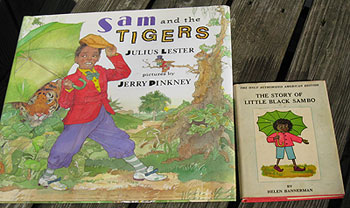 When my nephew was younger, I gave him children’s books for Christmas. It became a family joke. Whenever he was handed the gift from me, everyone wondered aloud what could it be. He eagerly ripped off the paper and acted like it was the best gift he had gotten.
When my nephew was younger, I gave him children’s books for Christmas. It became a family joke. Whenever he was handed the gift from me, everyone wondered aloud what could it be. He eagerly ripped off the paper and acted like it was the best gift he had gotten.
These weren’t just any children’s books. They were books about black children with images of them on the cover and in the stories. One of my most favorite illustrators is Jerry Pinkney. I would go to the children’s section of bookstores, stand at the shelves or sit in one of those tiny chairs to read children’s book and marvel at Pinkney’s illustrations. So much beauty in the swirl of a pen and the swoop of a line.
I’d also buy black children’s books for myself. I have a collection of books with artwork by noted African American artists: Faith Ringgold, Jacob Lawrence, Romare Bearden, Basquiat, Gwen Everett (wife of Lawrence who was also an excellent painter). I have a few reprints of three books of poetry and stories by Langston Hughes.
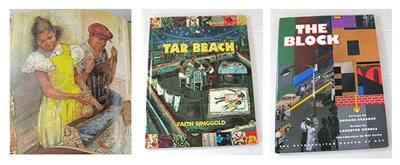
When I was in Paris some years ago, I even picked up two books there in French – with black characters, of course. I don’t speak the language, but illustrations are universal. I also have books by the Wyeths, N.C. and Andrew.
I have about a half-dozen of Pinckney’s books, including “John Henry,” one of several collaborative books with author Julius Lester. I met Pinkney a few months ago at a book festival in Philadelphia, where I found him under a tent reading “John Henry” to children. I took along a handful of his books for him to autograph. He did so obligingly, and I spent some time talking to him.
When he was growing up in Philadelphia in the 1940s, he said, “I didn’t see myself in the stories I read.” He was dyslexic, and his parents gave him and his siblings paper and pencils to draw with. “Drawing helped build my self-esteem,” he said. He said he took graphic arts classes at the Pennsylvania Academy of the Fine Arts “to appease my father.” His first illustrated book was in 1964.
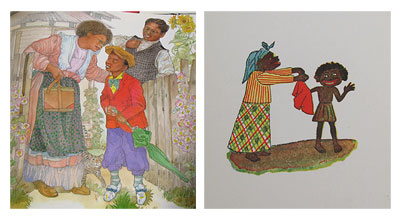
One of my favorite books is “Sam and the Tigers,” a re-telling of the Little Black Sambo story by Lester, with Pinkney’s illustrations. Take a look below at Pinkney’s illustration of the boy with his red coat next to the illustration from a Helen Bannerman book I got at an auction. The book still has its dust jacket, which says that it is “The Only Authorized American Edition of The Story Of Little Black Sambo.” The book was written by a Scottish woman living in Indian writing about (or caricaturizing) the indigneous people, according to my Google research.
When it was published in the U.S. and other places in later editions, the book and its name (which had been used to refer derogatively to black people) became associated with black people.
Vintage (and new) children’s books come up at auction pretty often. And I’ve begun to bid on a few now and then. At a recent auction, there were several boxes of old Golden Books and Wonder Books. I flipped through a few boxes and found one that interested me. I bid on it and paid $5.
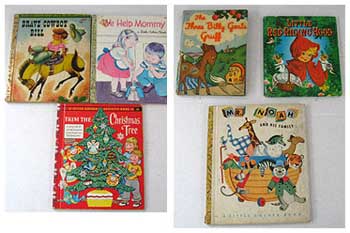
I couldn’t wait to get the box home and discover what books were inside. There were books about children and animals, and Hiawatha and Horton. The earliest was “Little Toot,” a 1939 book about a little boat, and others from the 1940s and 1950s.
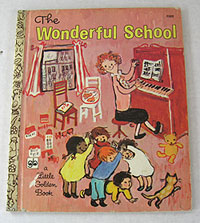 Of the more than 100 books in the box, only one had a black child on the cover. It was a book from the 1970s (and there were lots of books from the 1970s). That’s why I love what Jerry Pinkney and other illustrators gave me: A gift that showed my nephew that he was beautiful and that he mattered.
Of the more than 100 books in the box, only one had a black child on the cover. It was a book from the 1970s (and there were lots of books from the 1970s). That’s why I love what Jerry Pinkney and other illustrators gave me: A gift that showed my nephew that he was beautiful and that he mattered.
